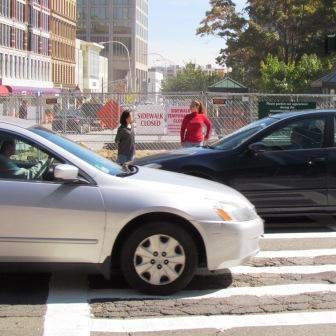
Comparative fault law allows apportionment of negligence among multiple parties who may share liability for one injury.
Suppose a pedestrian runs across the street. A car runs a red light, striking a second car which, while going through a green light, is speeding. The impact pushes the speeder into the pedestrian, who is pushed into a utility company “manhole” that was negligently left open. The pedestrian, who was jaywalking outside the crosswalk, sustains a catastrophic injury.
There’s enough fault to go around here. Comparative negligence allows courts, juries and claims adjusters to apportion fault accordingly. The general concept of comparative fault divides the total amount of damages among the speeder, the red light runner and the utility in proportion with the fault of each of the negligent parties.
But what about the pedestrian’s own negligence?
Contributory Negligence
Under the harsh common law doctrine of pure contributory negligence, if a person was injured even in part due to their own negligence they were prevented from collecting anything from another party. Pure contributory negligence prohibits the pedestrian above from collecting anything if found even partially responsible for his own injuries due to jaywalking.
Comparative Fault
Harsh consequences of pure contributory negligence are not the rule in many states. Under comparative fault law, the plaintiff’s own negligence, if any, is measured in comparison with the total negligence of all the defendants.
For example, in Massachusetts, the comparative negligence statute provides that contributory negligence shall not prevent the plaintiff from an award for damages if his or her own negligence was not greater than the total amount of negligence attributable to the person or persons against whom recovery is sought. So in many states, the pedestrian in our above accident is only prevented from recovering damages if their own negligence is greater than that of all of the other defendants.
So far so good. But, there’s a twist.
Joint and Several Liability
Under the legal doctrine of joint and several liability a person injured by more than one other party may sue any or all of them for the full amount of damages. The fact finder assigns a percent negligence to the injured person only so that any damage award can by the proportion of the injured party’s own fault.
Liable parties paying more than their share of damages may then seek partial reimbursement, or contribution, from other jointly liable parties, or ‘tortfeasors’. Liable parties who settle prior to final judgment are insulated from claims for contribution from the remaining defendants who are then entitled to a setoff in the judgment equal to the settlement amount.
New Hampshire law throws an additional twist into the mix. There, the law holds that true apportionment of damages in a law suit must include all potentially liable parties whether or not they are named parties to the civil action.
Under tort reform legislation applied by the NH courts, fault can be attributed to liable parties not included in a lawsuit. The apportionment to those parties is subtracted out of plaintiff’s award. [DeBenedetto v. CLD Consulting Engineers, NH Supreme Court, 2006.]
Comparative Fault Application
This summary reviews the general concepts. Different states apply individualized twists of their own to comparative fault and contributory negligence. This presents one of many reasons never to pursue something as important as your own injury case without experienced personal injury counsel. My office handles injury cases in Massachusetts and New Hampshire.
Views: 77





I found this article very clear and helpful. My attorney told me I had to share fault in a contributory negligence scheme but could not explain the concept without using legalese. Thank you for using normal language to clarify this concept.